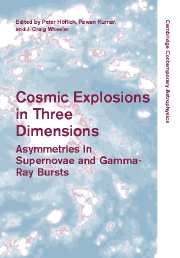Book contents
- Frontmatter
- Contents
- Part I Introduction
- Part II Supernovae: Observations Today
- Part III Theory of Thermonuclear Supernovae
- Part IV Theory of Core Collapse Supernovae
- 22 Rotation in core collapse progenitors: single and binary stars
- 23 Large scale convection and the convective supernova mechanism
- 24 Topics in core-collapse supernova-theory
- 25 MHD supernova jets: the missing link
- 26 Effects of super-strong magnetic fields in a core collapse supenova
- 27 Non-radial instability of stalled accretion shocks: advective-acoustic cycle
- 28 Asymmetry effects in hypernovae
- 29 Stellar abundances: the r-process and supernovae
- Part V Magnetars, N-Stars, Pulsars
- Part VI Gamma-ray Bursts
- Part VII Conference Summary
- References
29 - Stellar abundances: the r-process and supernovae
Published online by Cambridge University Press: 11 August 2009
- Frontmatter
- Contents
- Part I Introduction
- Part II Supernovae: Observations Today
- Part III Theory of Thermonuclear Supernovae
- Part IV Theory of Core Collapse Supernovae
- 22 Rotation in core collapse progenitors: single and binary stars
- 23 Large scale convection and the convective supernova mechanism
- 24 Topics in core-collapse supernova-theory
- 25 MHD supernova jets: the missing link
- 26 Effects of super-strong magnetic fields in a core collapse supenova
- 27 Non-radial instability of stalled accretion shocks: advective-acoustic cycle
- 28 Asymmetry effects in hypernovae
- 29 Stellar abundances: the r-process and supernovae
- Part V Magnetars, N-Stars, Pulsars
- Part VI Gamma-ray Bursts
- Part VII Conference Summary
- References
Summary
Abstract
Stellar abundance observations are providing important clues about the relationship between supernovae (SNe) and the rapid neutron capture process (i.e., the r-process). Although the site for the r-process is still not identified, events in and around SNe have long been suspected. Abundances of heavy neutron-capture elements in a number of stars suggest a robust r-process operating over billions of years, constraining astrophysical and nuclear conditions in supernova models. Variations in lighter n-capture element abundances — observed only very recently in any stars — could be explained as a signature of certain supernova models, or might require multiple r-process sites with different mass ranges or frequencies of SNe. Recent observations of elemental abundance scatter in the early Galaxy are consistent with earlier suggestions of a restricted range of SNe responsible for the r-process.
Introduction
The elements heavier than iron are synthesized in neutron processes, either in the (s)-low or (r)-apid process. In the s-process the timescale for neutron capture (τn) is much longer than the electron (beta)-decay (τβ) timescale. For the r-process, however, τn << τβ with many neutrons captured in a very short time period. As a result, neutron captures proceed into very neutron-rich regions far from the stable nuclei, where very little experimental nuclear data is available. This element synthesis is intimately connected to the late stages of stellar evolution, with the s-process occurring in the thermally pulsing helium shells of asymptotic giant branch (AGB) stars of low- and intermediate-mass (M ∼ 0.8–8 M⊙) (see, e.g., the review by Busso, Gallino, & Wasserburg 1999).
- Type
- Chapter
- Information
- Cosmic Explosions in Three DimensionsAsymmetries in Supernovae and Gamma-Ray Bursts, pp. 255 - 260Publisher: Cambridge University PressPrint publication year: 2004
References
- 1
- Cited by



